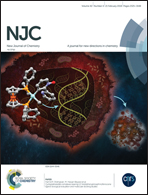Crystal structure, molecular packing, FMO, NBO, nonlinear optical and optical limiting properties of an organic imidazolium diphenylacetate diphenylacetic acid single crystal†
Abstract
An organic nonlinear optical (NLO) crystal, imidazolium diphenylacetate diphenylacetic acid (IDA), was synthesized and grown by the slow evaporation method. Formation of the new crystalline compound was confirmed by single crystal X-ray diffraction study. The title compound crystallizes in the triclinic crystal system with the space group P![[1 with combining macron]](https://www.rsc.org/images/entities/char_0031_0304.gif) . UV-vis-NIR spectral study showed that the grown crystal is transparent in the entire visible region with a lower cut-off wavelength of 275 nm. Density functional theory (DFT) calculations were carried out to calculate the frontier molecular orbitals and natural bonding orbitals of the IDA compound. The frontier energy gaps calculated theoretically were useful to understand the charge transfer taking place in the molecule. The natural bonding orbital analysis provides a convenient basis for the investigation of the charge transfer or conjugative interactions in the molecular system. Vicker's microhardness study revealed that the title material belongs to the soft material category. The values of fracture toughness, brittleness index and yield strength have also been calculated for Palmqvist and median types of cracks. The title compound IDA is thermally stable up to 201 °C, as assessed by thermogravimetric and differential thermal (TG-DTA) analyses. The specific heat capacity of IDA is found to be 3.25 J kg−1 K−1 at 65 °C. The laser induced surface damage threshold of the grown crystal was measured to be 0.2645 GW cm−2 with 1064 nm Nd:YAG laser radiation. The nonlinear refractive index (n2), absorption coefficient (β) and third order nonlinear susceptibility (χ(3)) were determined using the Z-scan technique. An optical limiting study revealed that the transmitted output power increases linearly with the input power up to an irradiance of around 3.6 mW cm−2.
. UV-vis-NIR spectral study showed that the grown crystal is transparent in the entire visible region with a lower cut-off wavelength of 275 nm. Density functional theory (DFT) calculations were carried out to calculate the frontier molecular orbitals and natural bonding orbitals of the IDA compound. The frontier energy gaps calculated theoretically were useful to understand the charge transfer taking place in the molecule. The natural bonding orbital analysis provides a convenient basis for the investigation of the charge transfer or conjugative interactions in the molecular system. Vicker's microhardness study revealed that the title material belongs to the soft material category. The values of fracture toughness, brittleness index and yield strength have also been calculated for Palmqvist and median types of cracks. The title compound IDA is thermally stable up to 201 °C, as assessed by thermogravimetric and differential thermal (TG-DTA) analyses. The specific heat capacity of IDA is found to be 3.25 J kg−1 K−1 at 65 °C. The laser induced surface damage threshold of the grown crystal was measured to be 0.2645 GW cm−2 with 1064 nm Nd:YAG laser radiation. The nonlinear refractive index (n2), absorption coefficient (β) and third order nonlinear susceptibility (χ(3)) were determined using the Z-scan technique. An optical limiting study revealed that the transmitted output power increases linearly with the input power up to an irradiance of around 3.6 mW cm−2.



 Please wait while we load your content...
Please wait while we load your content...